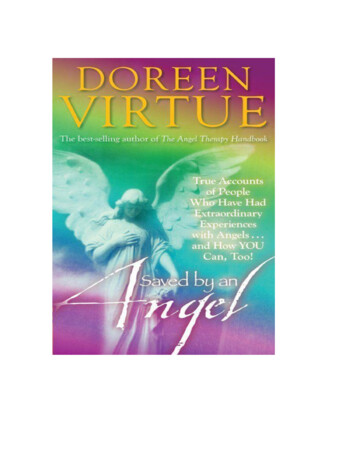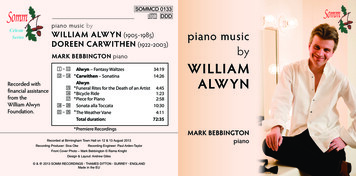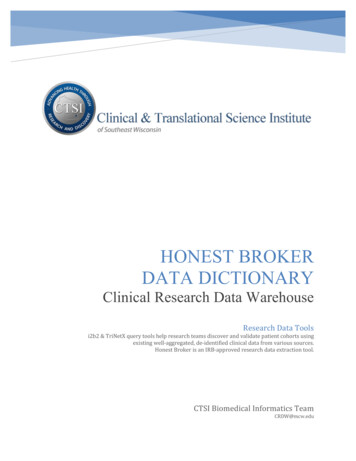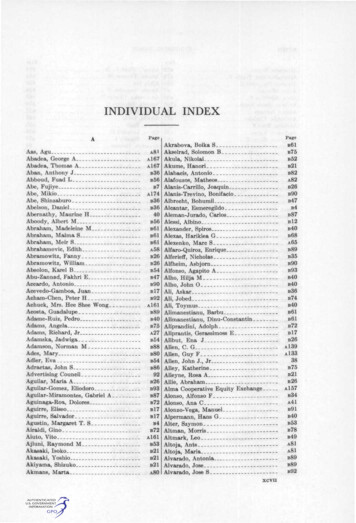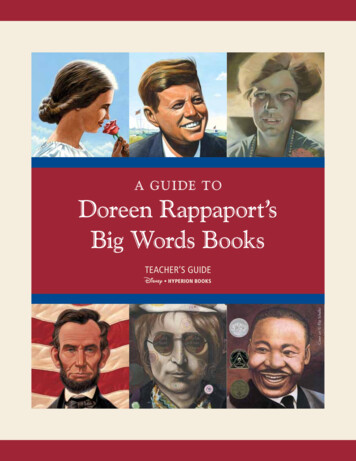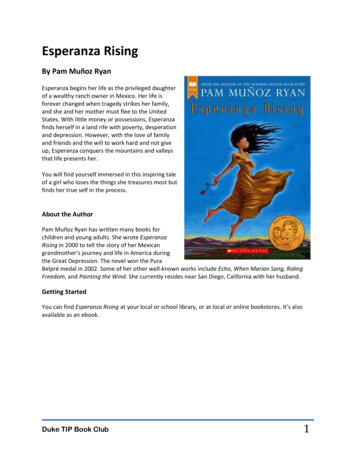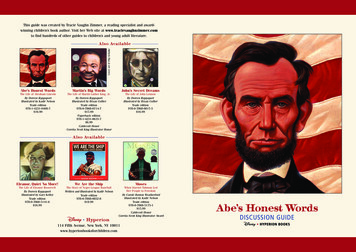
Transcription
This guide was created by Tracie Vaughn Zimmer, a reading specialist and awardwinning children’s book author. Visit her Web site at www.tracievaughnzimmer.comto find hundreds of other guides to children’s and young adult literature.Cover art Flip SchulkeAlso AvailableAbe’s Honest WordsMartin’s Big WordsJohn’s Secret DreamsThe Life of Abraham LincolnBy Doreen RappaportIllustrated by Kadir NelsonTrade edition978-1-4231-0408-7 16.99The Life of Martin Luther King, Jr.By Doreen RappaportIllustrated by Bryan CollierTrade edition978-0-7868-0714-7 15.99Paperback edition978-1-4231-0635-7 6.99Caldecott HonorCoretta Scott King Illustrator HonorThe Life of John LennonBy Doreen RappaportIllustrated by Bryan CollierTrade edition978-0-7868-0817-5 16.99Also AvailableEleanor, Quiet No More!We Are the ShipMosesThe Life of Eleanor RooseveltBy Doreen RappaportIllustrated by Gary KelleyTrade edition978-0-7868-5141-6 16.99The Story of Negro League BaseballWritten and Illustrated by Kadir NelsonTrade edition978-0-7868-0832-8 18.99When Harriet Tubman LedHer People to FreedomBy Carole Boston WeatherfordIllustrated by Kadir NelsonTrade edition978-0-7868-5175-1 15.99Caldecott HonorCoretta Scott King Illustrator AwardDisney Hyperion114 Fifth Avenue, New York, NY 10011www.hyperionbooksforchildren.comAbe’s Honest WordsDISCUSSION GUIDEDisney HYPERION BOOKS
About the BookPre-readingFrom the time he was a young man, Abraham Lincoln was pained by the crueltyBrainstorm a list of everything you know or believe about Abraham Lincoln.and evil of the institution of slavery. A voracious reader, Lincoln spent every sparemoment of his days filling his mind with knowledge—from history to literature tomathematics—preparing himself to one day lead the country he loved toward greaterQuestions to Considerequality and prosperity.1Why do you think the author makes a point to tell us in the first sentencethat Lincoln was born in a slave state?Despite the obstacles he faced as a self-educated man from the backwoods, Lincolnpersevered in his political career, and his compassion and honesty gradually earnedhim the trust of many Americans. As president, he guided the nation through a long2Describe Lincoln’s early years and compare them to your own.3Why are some of the words in the book printed in italic? Why do you thinkand bitter civil war and penned the document that would lead to the end of slaveryin the United States. Told in Doreen Rappaport’s accessible, absorbing prose, thepassion for humanity that defined Lincoln’s life shines through in this momentousthe author decided to include them?follow-up to Martin’s Big Words and John’s Secret Dreams.4The quotes in this book have been taken from Lincoln's notebooks, letters to friends,Why do you think Abraham Lincoln lived in so many different places?Why do people move? Has that changed over time?campaign speeches for state legislature, campaign speeches for president, his firstinaugural address, the Gettysburg Address, and the second Inaugural address. His5Who did Abraham Lincoln like to listen to? Who do you like to listen to? Why?6What did Lincoln see happen in New Orleans? Do you think it changed himwords have been edited and shortened without changing their meaning.or only convinced him of the feeling he already had? Defend your answer.7What jobs did Lincoln have? Did they correspond to what he liked to study?How did he get them to match? Which job would you most like to have?Which jobs would you least like to do?8Why did people like Lincoln? Did he always win the office in governmentthat he wanted?9What happened just as Lincoln was elected President? Did he think of theSouth as the enemy of the Union? What makes you think so or not?
10 Why did people doubt Lincoln’s skill to lead the country during war?How did he react to everyone’s negative views of him?11 What was the Emancipation Proclamation? Why was it important? Wheredid it count the most? How did Lincoln get it to make a difference in theProjectsLanguage ArtsInspired by the clear and lyrical prose of Doreen Rappaport, write a biography ofanother important American hero inspired by Abe’s Honest Words.North too?Public Speaking12 How did Lincoln plan to put the country back together without hatred?Why did he never get the chance?Encourage students to learn sentences at the back of the book from the GettysburgAddress. In groups or in front of the whole class or school, have them performthe speech, in a suitable manner. Ask them how it feels to speak the words ofAbraham Lincoln.ReadingIn the following chart, pull important facts, quotes, or details from the book and listthem on the left side. On the right, share your reactions including feelings, thoughts,memories, or connections you made to the text.Important Quotes,Facts or DetailsEx. “He had just a mite of schooling,yet he loved words.”Connections andReactionsWow! I just figured that Lincoln didn’thave much schooling, but his passionfor education came from reading books.
MusicLearn the lyrics for both “Yankee Doodle” and “Dixie.” After singing them, discussAbout the Authorwhat the lyrics mean.Doreen Rappaport has written numerous awardwinning books for children, including: Freedom Ship andSocial StudiesThe School Is Not White!, both illustrated by Curtis James;Create a three-dimensional map of the United States as it looked during the Civil War.Martin’s Big Words: The Life of Dr. Martin Luther King, Jr.,Be sure to label which states fought for the Union and which for the Confederacy.a Caldecott Honor Book, a Jane Addams Children’s BookAward winner, and a Coretta Scott King Honor Book; andDates to RememberJohn’s Secret Dreams: The Life of John Lennon, bothFebruary 12, 2009, is the 200th anniversary of Lincoln’s Birth. His birthday is aillustrated by Bryan Collier. She lives and writes inlegal holiday in some U.S. States, but even if it’s not, remember to celebrate theUpstate New York.anniversary of his birth.November 19, 1863, is the date he gave the Gettysburg Address, students mayenjoy revisiting the speech on or around that date.An Interview with Doreen RappaportOther important dates of interest can be found at the back of Abe’s Honest Words.1You grew up in a family of musicians—what inspired you to go in a differentdirection and become a writer?I was teaching music in a junior high school in the ’60s and wanted to find somebooks for children on the evolution of the black musical experience. I couldn’tfind any. This was right before I went to Mississippi to teach in a freedom school.The Civil Rights Movement was making me aware of the many great true storiesabout black Americans that had been excluded from our history. These two“missing” threads made me move to write books on neglected history subjects.2 African American history has been a major influence on much of your work.What sparked the interest and passion for these often unknown stories?The extraordinary courage of black Americans during the Civil Rights Movementpropelled me to learn more about other black Americans, starting back in thedays of slavery. And what I learned in my reading was that there were so manycourageous black Americans all through American history—people who hadfought against overwhelming odds, who had suffered but persevered, who hadblazed trails that were picked up by the next generation or two generations.These Americans created my passion for telling their stories.
3 Your newest picture book offers a portrait of Abraham Lincoln. Tell us aA great leader who follows his heart and convictions can help a nation find itslittle about your research for this project and any interesting discoveriesway. Our leaders must take moral stands without worrying about criticism andyou made.the polls and their reelection. As Lincoln said, “If I were to read, much lessMy research began with the great biographies of Lincoln, including Carl Sandburg’sanswer, all the attacks made on me, this shop might as well be closed for anypoetic vision and Stephen Oates’s deconstruction of the Lincoln myths, to give usother business. I do the very best I know how—the very best I can; and I meanthe man behind the various myth, and David Herbert Donald’s dense and rivetingto keep doing so until the end.”biography with details that illuminated Lincoln’s character. Gary Wills’s book onthe Gettysburg Address led me to reread all of Lincoln’s speeches and think about8 While working on your own book, did you come across any other bookshis choice of language in every instance. I could feel Lincoln’s great burden as(for children and/or adults) that you can recommend?he tried to keep this country together and the torment he must have felt as heI loved the poetic voice and first-person approach used by Ann Turner in herstruggled to finally make the decision that he had to free black men, women, andbiography, Abe Lincoln Remembers. Older readers will devour Russell Freedman’schildren, a decision that threatened the fragile alliance of the border states withdense, beautifully written Lincoln: A Photobiography.the North.9 Any recommendations for bookstores or libraries that are hoping to throw4 Much has been written for children and adults about Abe. How did youa kid-centric Lincoln bicentennial celebration?approach your biographical sketch to make it different and new?When I was young, we had to memorize various speeches of famous people,In writing biographies for young people, I try to find what I believe is theincluding Lincoln’s speeches. It was tough, but it felt great to get up in front of“essence” or “essences” of a particular person. Lincoln’s eloquent words arepeople and pretend to be a famous person speaking his or her words. Let’s havea guide into his thoughts and offer children a way into the heart of the man.Lincoln marathons in bookstores and libraries celebrating Lincoln’s words withkids of all ages. Call up the schools, have children memorize his speeches, then5 Was it difficult to narrow down all of the information on Lincoln andcome in and read them. Let them stand in front of a loudspeaker and let themake it accessible for a young audience?great words of this man ring through the stores. And don’t eliminate the youngerABSOLUTELY! It’s the big challenge in writing for a young audience. You do tonschildren; in the early grades, each child can memorize one sentence and we willof research, know so much more than you can put in the book, and have to workhear various voices of the young strung together.hard to simplify but NOT dumb down.10 What’s next?6 Kadir Nelson illustrated Abe’s Honest Words. Did you two work collaborativelyEleanor, Quiet No More! The Life of Eleanor Roosevelt, illustrated by Gary Kelley.throughout the process or was the writing and art creation separate?I saw Kadir’s sketches and made comments that he received. My comments areabout historical accuracy or focus, never about an artist’s vision.711 Anything else you’d like to add?Kids, read, read, read! There’s so much that can be learned through reading history.In 2009, we will celebrate the bicentennial of Lincoln’s birth. What do youhope young readers take away from Lincoln’s life and accomplishments?I hope children will see what is possible under great leadership in this country.Copyright 2008 by Ingram Book Company. This interview originally appeared in the November/December2008 issue of Children’s Advance, the Ingram Book Magazine.
About the Illustratorphotographs. I was able to paint his likeness from new perspectives by using alife-size cast of Lincoln’s bust. It enabled me to light the sculpture in any way IKadir Nelson is a two-time Caldecott Honor illustratorwished and draw and paint Lincoln from any angle I needed.of many books for children, including Moses: When HarrietTubman Led Her People to Freedom by Carole Boston3 What medium did you use for the illustrations, and can you tell us a littleWeatherford, an NAACP Image Award winner, a Caldecottabout your process?Honor Book, and a Coretta Scott King Illustrator AwardThe illustrations for Abe’s Honest Words were rendered in pencil, watercolor,winner. He also wrote and illustrated the book We Are theand oil on paper (in that order). My process is pretty straightforward. I createShip: The Story of Negro League Baseball. He lives witheach sketch, and then find supporting historical and visual reference in books,his family in southern California.photography, on the Internet, and in this case, on location. I then drew the sketchto size, painted over the pencil drawing with watercolors, and then finished thepainting with oils.An Interview with Kadir Nelson1What kind of research did you do before beginning your illustrations forAbe’s Honest Words?As part of my research for the artwork, I read a couple of biographies aboutLincoln. I also traveled to Springfield, Illinois, to see firsthand where Lincoln livedand came into his own before he became president. Camera in hand, I visitedNew Salem, a replica of a village just outside of Springfield, where Lincoln lived ashort while after he left home. I walked through Lincoln’s Springfield home, theOld State Capitol where Lincoln gave his famous “House Divided” speech, and hisold law offices. I found wonderful reference at the Abraham Lincoln PresidentialMuseum and library there, as well as in Washington D.C., where I toured the U.S.Capitol building and spent time at the Lincoln Memorial. I did all of this to get aclearer picture of Lincoln’s journey, and found the experience to be invaluableand inspiring.2 Were there any specific challenges in capturing such an iconic historicalfigure in what is arguably a fresh new way?The only challenge I found when creating images of Lincoln was showing himfrom angles that are different from those I found in existing paintings and
winning children’s book author. Visit her Web site at www.tracievaughnzimmer.com to find hundreds of other guides to children’s and young adult literature. Abe’s Honest Words DISCUSSION GUIDE Disney HYPERION BOOKS Abe’s Honest Words The Life of Abraham Lincoln By Doreen Rappaport


